

Michael Hauge's Workshop: Combining Emotional Journeys and External Plots. Over the past couple of weeks, I’ve been sharing tips from Michael Hauge’s presentation at the Romance Writers of America (RWA) Conference.

First we looked at how to make sure our love (or romantic interest) stories didn’t fall prey to a lame “love at first sight” relationship. Then we talked about how to show that our characters really are the perfect match. Along the way, we discussed the elements that make up a character’s inner conflict. Janice Hardy attended Michael Hauge‘s workshop, “Using Inner Conflict to Create Powerful Love Stories,” with me, and she wrote up a fabulous post yesterday, going into those elements (longing/need, wound, belief, fear, identity, and essence) in detail (and giving great advice about how to apply Michael’s tips to non-romance stories). Birth of a Book: The Development Stage: Creating the Characters. By Janice Hardy, @Janice_Hardy Part of the Early Stages of a Novel Series Over the last month, We've been going through the early stages of writing a novel.
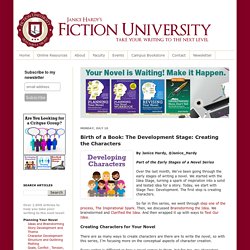
We started with the Idea Stage, turning a spark of inspiration into a solid and tested idea for a story. MASTER LIST of Facial Expressions for Writers! – Bryn Donovan. Writers need good descriptions of facial expressions in their stories to help the readers picture the characters, to convey emotions, and to set up lines of dialogue without having to write “said” or any of its synonyms.
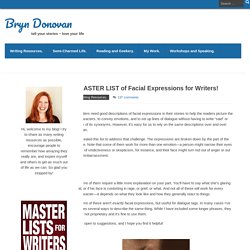
However, it’s easy for us to rely on the same descriptions over and over again. I created this list to address that challenge. The expressions are broken down by the part of the face. Note that some of them work for more than one emotion—a person might narrow their eyes out of vindictiveness or skepticism, for instance, and their face might turn red out of anger or out of embarrassment. What Does Your Body Language Say About You? How To Read Signs and Recognize Gestures - Jinxi Boo - Jinxi Boo. Art by LaetitziaAs we all know, communication is essential in society.

Advancements in technology have transformed the way that we correspond with others in the modern world. Because of the constant buzz in our technological world, it's easy to forget how important communicating face-to-face is. When conversing old-school style, it's not only speech we verbalize that matters, but what our nonverbal gestures articulate as well. MASTER LIST of Physical Descriptions! – Bryn Donovan. Sometimes it can be hard to find the right words to describe individual facial features, faces in general, bodies, and even hair.
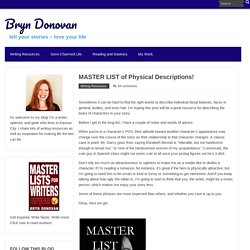
I’m hoping this post will be a good resource for describing the looks of characters in your story. Before I get to the long list, I have a couple of notes and words of advice: 4 Super Easy Ways To Create Characters For Short Stories – Writers Write. Characters in Novels versus Characters in Short Stories Creating characters in short stories is the same as creating characters in novels, but once again, when dealing with a reduced word count we have to make our writing work harder.

We don’t have 80 000 words to develop a character arc. How to Write Characters That Feel Real. What are some tips for creating characters that feel very real and full?
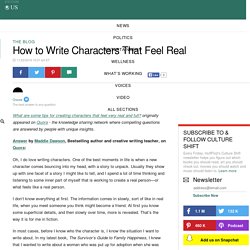
Originally appeared on Quora - the knowledge sharing network where compelling questions are answered by people with unique insights. Answer by Maddie Dawson, Bestselling author and creative writing teacher, on Quora: Oh, I do love writing characters. One of the best moments in life is when a new character comes bouncing into my head, with a story to unpack. Usually they show up with one facet of a story I might like to tell, and I spend a lot of time thinking and listening to some inner part of myself that is working to create a real person—or what feels like a real person. Advanced Craft Tips. I do a lot of critiquing.
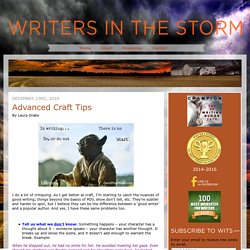
As I get better at craft, I’m starting to catch the nuances of good writing; things beyond the basics of POV, show don’t tell, etc. They’re subtler and harder to spot, but I believe they can be the difference between a ‘good writer’ and a popular author. And yes, I have these same problems too. Tell us what we don’t know: Something happens – your character has a thought about it – someone speaks – your character has another thought. It breaks up and slows the scene, and it doesn’t add enough to warrant the break. When he stepped out, he had no smile for her. The presentation must have gone badly. Do you see how the thought is not only unneeded – but that it weakens the sentences above it? Knowing I can’t go out there, the walls seem to crowd me, closer than they were a few minutes ago. Her sobs over the phone claw my insides. Anchor us in deep POV: Adam is the POV character below. A-helpful-chart-of-facial-expressions.
Netherlands national costumes Archive. Seven Maxims of Storytelling, Part One. “First, find out what your hero wants, then just follow him!”
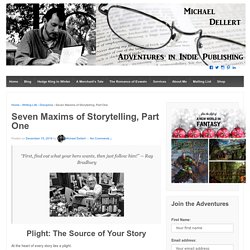
— Ray Bradbury Plight: The Source of Your Story At the heart of every story lies a plight. Notice that it’s not a question. Your protagonist has a plight. The only question is, “How effectively have you explored your protagonist’s plight?” Through exploration of your protagonist’s plight, you come to the most dynamic version of your story, the very heart and soul of your story, the place from which all the tensions and frustrations and conflicts bubble up and erupt.
Laura Drake presents: Advanced Craft Tips. Please welcome back author Laura Drake!
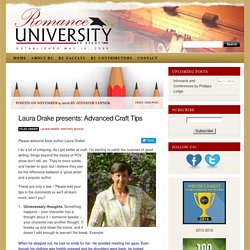
I do a lot of critiquing. As I get better at craft, I’m starting to catch the nuances of good writing; things beyond the basics of POV, show don’t tell, etc. They’re more subtle, and harder to spot, but I believe they can be the difference between a ‘good writer’ and a popular author. An Easy Fix for a Tighter Point of View. Writers In The Storm is delighted to have Janice Hardy back. We love her and the fabulous writing resources on her blog, The Other Side of the Story.
Decades ago, a detached, omniscient point of view was all the rage. Readers wanted to be told a story, so the stories read as if someone was indeed telling them. That style faded as readers sought a more immersive read, and tight points of view became popular. Regardless of who the narrator is, that’s the person the reader experiences the novel through.
Do Your Settings Contain An Emotional Value? - WRITERS HELPING WRITERS® As writers, we try to draw readers fully into each scene. Not only do we want them to picture what’s happening, we want them to feel as if they are sharing the POV (point of view) character’s experience. Shared experiences are all about emotion, and Deep POV is one of the best ways to encourage feelings to pass between readers and characters. To achieve this level of closeness, details from the character’s world are filtered through the point of view character’s emotions and senses. Readers not only see, hear, smell, taste, and touch what the character does…they feel as well. Imagine a character on a moonlit walk across a football field, enjoying the clean scent of grass, the glimmer of dew, and the chance to be alone.
But change the description (a cold breeze kicking up, the unsettling flap of a raised school flag in the darkness, shadows clustering at the field’s edge) and the mood shifts. As you can see, shared emotional moments help readers immerse themselves into the story. Save. Creating Characters. 2. characters. Characters. Characters. Creating Stunning Character Arcs, Pt. 2: The Lie Your Character Believes. People hate change. We may sit around and wish our lives were different, but when the rubber really starts streaking the tarmac, we usually find ourselves wishing we could just hang out here in our safe and familiar haunts. Characters are no different. They resist change just as staunchly as any of us—which is a good thing. Out of resistance comes conflict; out of conflict comes plot. This is just the first of many ways in which plot and character arcs are inextricable from one another.
3 Types of Character Arcs: Choose the Best for Your Novel. How Does Your Character Change? You know your character must change somehow over the course of your novel. But how? And more than that, how do you sync the changes with the external plot? The middle of a novel can suffer from the dreaded “sagging middle” and it’s mainly because you don’t have a firm handle on the character’s inner arc and how it meshes with external events. I’ve found three approaches to the inner arc, each trying to laying out how the character changes. Hero’s Journey: Quest for Inner Change In the Hero’s Journey, laid out so well in Christopher Vogler’s book, The Writer’s Journey, a character receives a Call to Adventure that takes him/her out of the normal and ordinary world into a world where they must quest for something. Villain. How To Get People To Like You: 7 Ways From An FBI Behavior Expert.
Before we commence with the festivities, I wanted to thank everyone for helping my first book become a Wall Street Journal bestseller. To check it out, click here. Meeting new people can be awkward. Mixed Signals: Why People Misunderstand Each Other. In her new book No One Understands You and What To Do About It, Heidi Grant Halvorson tells readers a story about her friend, Tim. Character Education Resource Hub. Personnages. Describing appearanes. MASTER LIST of Facial Expressions! The Seven Characteristics of a Good Leader. English vocabulary: personality types. Words to describe people.
What is Character Development? I remember back when cameras had something inside them called film that you had to get developed. Character Bio Template by kitkattykomodo on DeviantArt. Getting the Best Response From Your Characters. By Janice Hardy. Set Up or Start Up? Making Critical Character Traits Part of Your Plot. By Janice Hardy, @Janice_Hardy. Hidden Emotions: How To Tell Readers What Characters Don’t Want To Show - WRITERS HELPING WRITERSWRITERS HELPING WRITERS. Conflict. How to Write in Deep POV + get inside the mind of your character. Photo cred: © Paolo Imbag via Unsplash. 35 Weird Traits Your Characters May Have.
10 Odd Emotions You May Have Experienced. Second Fiddle, Sweeter Music—Using Secondary Characters To Give Your Novel A Bigger Feel. By Bonnie Randall Special Guest Author Two things I love as a writer and a reader: deep, emotionally wrought stories, and authentic, rich characters. I am a firm believer that a novel is only as deep as the characters who populate it and, having spent a lifetime reading, a fair chunk of it writing, and devoting a lot of time studying reflections of those who craft great prose, the following are my thoughts on employing secondary characters to give your book greater, richer depth. Descriptors. Writing Character Development. Characters. Creating Characters. What Jane Eyre Can Teach You About Mind-Blowing Heroines - The Procrastiwriter. What Jane Eyre Can Teach You About Mind-Blowing Heroines. On Writing Convincing Male Characters. Creating Compelling Characters.
Body Language and Flirting - Blifaloo. 25 Acts of Body Language to Avoid. Recognize these emotions. Things You Should Know About Your Character. Contrasting and categorization of emotions. Emotions – How To Understand, Identify and Release Your Emotions. Facial Expressions. Gestures and Body Language. What Does Your Body Language Say About You? How To Read Signs and Recognize Gestures - Jinxi Boo - Jinxi Boo. Body Language Basics - Syncrat Publishing.
The Female Character Flowchart. Of Character Voices & Slang. Creative-writing-now.com - StumbleUpon. Micro Expressions - Research, Theory & Lying. Character. Character Development.
How to Write in Deep POV + get inside the mind of your character. 123 Ideas for Character Flaws) 100 Character Development Questions for Writers - Gather.com : Gather.com. Characters For an Epic Tale. Understanding Your Hero’s Life BEFORE the Journey Begins. Twelve_Character_Archetypes.pdf. Characters. Generating Page-Turning Momentum—Characters & The Wound. Writing Characters. Character. Appearance Generator. Personality Generator. Character Descriptions – Learn from the Pros! Anti-Villain. How to introduce a character. Character templates development. Characterisation. Character. Creating Characters. How to Write in Deep POV + get inside the mind of your character.
Resources for Developing Characters. Can You Guess These Classic Fictional Characters Just By Their Description? Questionnaires for Writing Character Profiles - Creative Writing Help. Character and Personality Adjectives - Tasks. Character Trait Descriptive Adjectives. Creating memorable fictional characters UWA Extension. Character Archetypes. Character Psychology: 9 Common Errors — Guest: Kassandra Lamb. What Jane Eyre Can Teach You About Mind-Blowing Heroines. 25 Things You Should Know About Character. 123 Ideas for Character Flaws) 5 Tips on How to Write From the Opposite Gender. The 10 Types of Writers’ Block (and How to Overcome Them) Creating Stunning Character Arcs, Pt. 2: The Lie Your Character Believes.